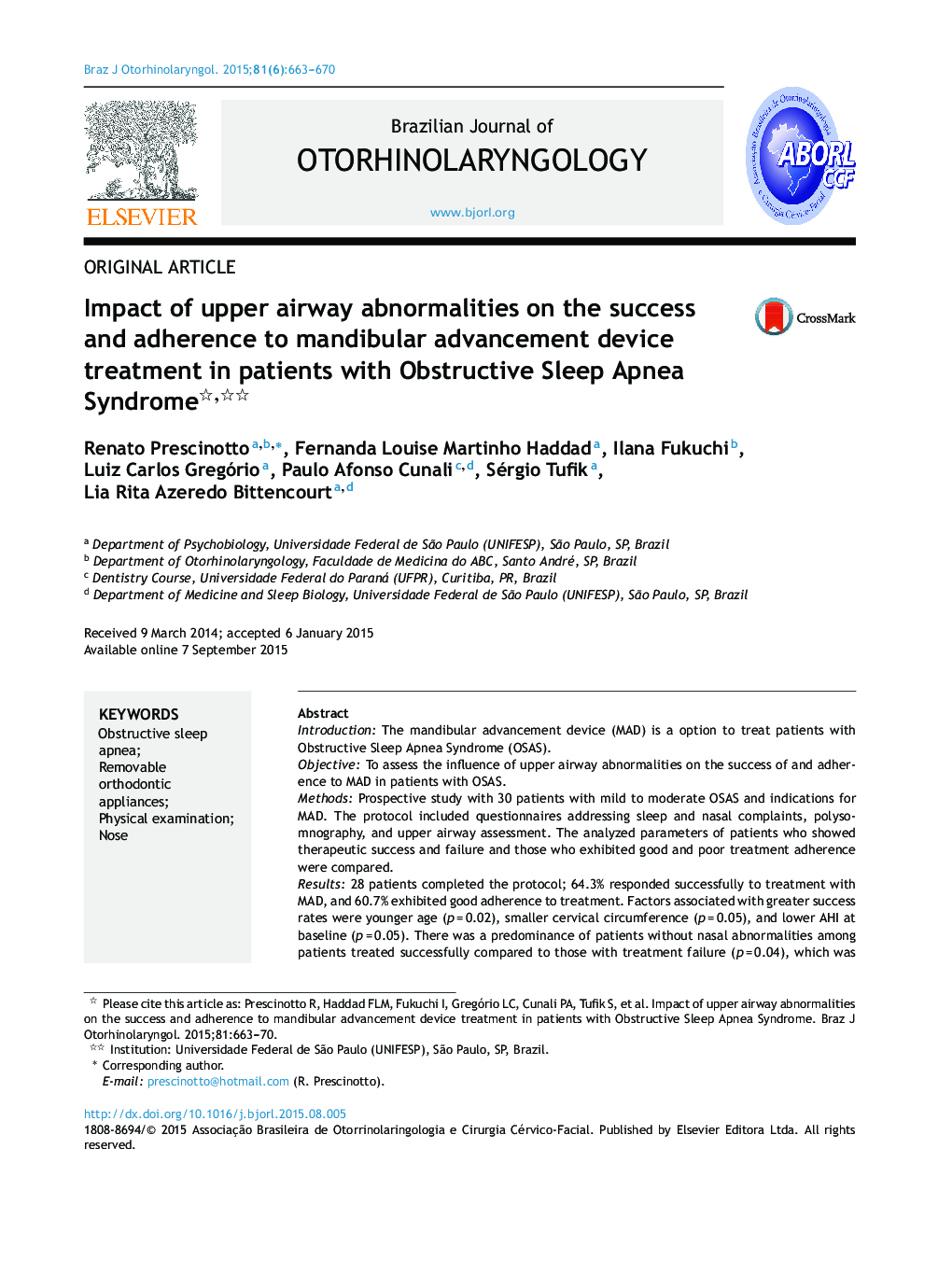| کد مقاله | کد نشریه | سال انتشار | مقاله انگلیسی | نسخه تمام متن |
|---|---|---|---|---|
| 4106266 | 1605364 | 2015 | 8 صفحه PDF | دانلود رایگان |
IntroductionThe mandibular advancement device (MAD) is a option to treat patients with Obstructive Sleep Apnea Syndrome (OSAS).ObjectiveTo assess the influence of upper airway abnormalities on the success of and adherence to MAD in patients with OSAS.MethodsProspective study with 30 patients with mild to moderate OSAS and indications for MAD. The protocol included questionnaires addressing sleep and nasal complaints, polysomnography, and upper airway assessment. The analyzed parameters of patients who showed therapeutic success and failure and those who exhibited good and poor treatment adherence were compared.Results28 patients completed the protocol; 64.3% responded successfully to treatment with MAD, and 60.7% exhibited good adherence to treatment. Factors associated with greater success rates were younger age (p = 0.02), smaller cervical circumference (p = 0.05), and lower AHI at baseline (p = 0.05). There was a predominance of patients without nasal abnormalities among patients treated successfully compared to those with treatment failure (p = 0.04), which was not observed in relation to adherence. Neither pharyngeal nor facial skeletal abnormalities were significantly associated with either therapeutic success or adherence.ConclusionMAD treatment success was significantly lower among patients with nasal abnormalities; however, treatment adherence was not influenced by the presence of upper airway or facial skeletal abnormalities.
ResumoIntroduçãoO Aparelho Intraoral (AIO) é uma opção para tratamento da Síndrome da Apneia Obstrutiva do Sono (SAOS).ObjetivosAvaliar a influência das alterações da VAS e esqueléticas faciais através de uma avaliação clinica sistematizada no sucesso e adesão ao (AIO) em pacientes com (SAOS).MétodoEstudo prospectivo em que foram avaliados 30 pacientes com SAOS leve a moderada e indicação de AIO. Protocolo incluiu questionários de sono e queixas nasais; polissonografia e avaliação da VAS por rinoscopia anterior e oroscopia. Os parâmetros analisados foram comparados entre pacientes com sucesso e insucesso, e com boa e má adesão à terapia.ResultadosCompletaram o protocolo 28 pacientes. O sucesso ao tratamento foi de 64,3% e a adesão 60,7%. Os fatores associados ao sucesso foram menor idade, menor circunferência cervical e menor IAH basal. Quanto à presença de alterações nasais, houve predomínio de pacientes sem alteração nasal entre os pacientes com sucesso comparados àqueles com insucesso (p = 0,04); o que não foi observado em relação à adesão. Quanto às alterações faríngeas e alterações esqueléticas faciais, não houve significância.ConclusãoO sucesso do tratamento com AIO foi significativamente menor nos pacientes com alterações nasais, porém a adesão não foi influenciada pela presença de alterações de VAS ou esqueléticas faciais.
Journal: Brazilian Journal of Otorhinolaryngology - Volume 81, Issue 6, November–December 2015, Pages 663–670
